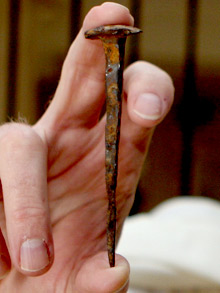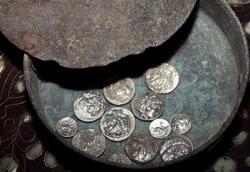
The four-inch long nail is thought to be one of thousands used in crucifixions across the Roman empire.
Archaeologists believe it dates from either the first or second century AD.
The nail was found last summer in a decorated box in a fort on the tiny isle of Ilheu de Pontinha, just off the coast of Madeira.
Pontinha was thought to have been held by the Knights Templar, the religious order that was part of the Christian forces which occupied Jerusalem during the Crusades in the 12th century.
The knights were part of the plot of Dan Brown's best-selling novel, The Da Vinci Code.
Bryn Walters, an archaeologist, said the iron nail's remarkable condition suggested it had been handed with extreme care, as if it was a relic.
"It dates from the first to second centuries," he told the Daily Mirror.
While one would expect the surface to be "pitted and rough" he said on this nail the surface was smooth.
That suggested that many people had handled it over the centuries, with the acid on their hands giving it a "peculiar finish".
Christopher Macklin of the Knights Templar of Britannia said the discovery was "momentous".
He said the original Knights Templar may have thought it was one of the nails used in Christ's crucifixion.
The nail was found together with three skeletons and three swords.
One of the swords had the Knight Templar's cross inscribed on it.
Archaeologists believe it dates from either the first or second century AD.
The nail was found last summer in a decorated box in a fort on the tiny isle of Ilheu de Pontinha, just off the coast of Madeira.
Pontinha was thought to have been held by the Knights Templar, the religious order that was part of the Christian forces which occupied Jerusalem during the Crusades in the 12th century.
The knights were part of the plot of Dan Brown's best-selling novel, The Da Vinci Code.
Bryn Walters, an archaeologist, said the iron nail's remarkable condition suggested it had been handed with extreme care, as if it was a relic.
"It dates from the first to second centuries," he told the Daily Mirror.
While one would expect the surface to be "pitted and rough" he said on this nail the surface was smooth.
That suggested that many people had handled it over the centuries, with the acid on their hands giving it a "peculiar finish".
Christopher Macklin of the Knights Templar of Britannia said the discovery was "momentous".
He said the original Knights Templar may have thought it was one of the nails used in Christ's crucifixion.
The nail was found together with three skeletons and three swords.
One of the swords had the Knight Templar's cross inscribed on it.


 RSS Feed
RSS Feed